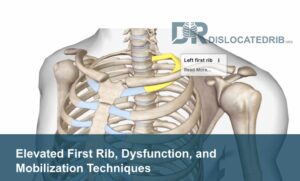Suffering from a rib injury can be both painful and limiting, affecting your daily activities and overall quality of life. However, incorporating yoga into your recovery process can offer a gentle yet effective way to enhance healing, improve flexibility, and reduce pain. This comprehensive guide explores the benefits of yoga for rib injury recovery, outlines specific poses that are beneficial, and provides essential safety tips to ensure a successful healing journey.
Yoga has been practiced for centuries as a holistic approach to physical and mental well-being. While it is well-known for its flexibility and stress-relief benefits, it can also play a significant role in healing and maintaining the health of our ribs.
Types of Rib Injuries
Rib injuries can vary in severity, from mild bruising to fractures. Understanding the different types of rib injuries is crucial for effective treatment and recovery. Common rib injuries include:
- Rib Contusions: Bruising of the ribcage caused by blunt force trauma.
- Rib Fractures: Partial or complete breaks in the rib bones.
- Costochondritis: Inflammation of the cartilage connecting ribs to the breastbone.
- Intercostal Muscle Strain: Overuse or sudden movements can lead to muscle strains between the ribs.
Symptoms and Diagnosis
Identifying rib injuries is vital for timely treatment. Symptoms may include:
- Pain in the chest or ribcage
- Difficulty breathing deeply
- Swelling or tenderness around the ribs
- Bruising or discoloration
- Pain when moving or coughing
A medical professional can diagnose rib injuries through physical examination and imaging, such as X-rays or CT scans.
Benefits of Yoga for Rib Health
Yoga offers numerous benefits when it comes to rib health:
- Improved Breathing: Yoga emphasizes deep, controlled breathing, which can help expand lung capacity and alleviate breathing difficulties.
- Pain Relief: Gentle yoga poses and stretches can relieve pain associated with rib injuries.
- Enhanced Flexibility: Yoga promotes flexibility, which can prevent rib injuries in the first place.
- Stress Reduction: Reduced stress levels can aid in healing and prevent further complications.
Precautions Before Starting Yoga
Before beginning a yoga practice for rib health, consider these precautions:
- Consult a healthcare provider to ensure it’s safe for your specific condition.
- Inform your yoga instructor about your rib injury to receive personalized guidance.
- Start slowly and avoid poses that cause pain or discomfort.
Yoga Poses for Rib Injury Recovery
Child’s Pose (Balasana)
Child’s pose is a restful stretch that can relieve tension in the ribcage and improve breathing.
Cat-Cow Stretch (Marjaryasana-Bitilasana)
This gentle flow between arching and rounding your back can help alleviate rib pain and improve mobility.
Gentle Twists
Twisting poses like the seated twist can help release tension and improve ribcage flexibility.
Bridge Pose (Setu Bandha Sarvangasana)
Bridge pose strengthens the back and core muscles, providing support to the ribcage.
Deep Breathing Exercises
Practicing deep breathing exercises can enhance lung capacity and promote ribcage expansion.
Tips for a Safe Yoga Practice with Rib Injuries
- Listen to your body and avoid pushing yourself too hard.
- Use props like cushions or blocks for support during poses.
- Modify poses as needed to accommodate your injury.
Combining Yoga with Medical Treatment
Yoga should complement, not replace, medical treatment. Always follow your healthcare provider’s recommendations.
Conclusion
Yoga can be a powerful ally in healing from rib injuries and maintaining rib health. By incorporating specific poses and following safety guidelines, individuals can experience relief, improved flexibility, and a greater sense of well-being. Remember to consult with a healthcare provider before starting any new exercise regimen, especially if you have a pre-existing rib injury.
Yoga for rib injury – How to
Yoga, known for its holistic approach to physical and mental health, can play a pivotal role in the recovery from rib injuries. The practice of yoga involves stretching, controlled breathing, and mindfulness, all of which contribute to the healing process by enhancing circulation, reducing tension, and promoting relaxation.
Here are the steps to performing yoga to assist in healing your rib injury.
Child’s Pose (Balasana)
Child’s Pose, or Balasana, is a gentle and deeply relaxing yoga pose often used as a resting position during a yoga practice. It provides numerous benefits and is particularly valuable for individuals recovering from rib injuries or seeking to enhance their ribcage flexibility.
How to Perform Child’s Pose:
- Start by kneeling on the yoga mat with your big toes touching and knees spread apart, about hip-width distance.
- Sit back on your heels, keeping your spine straight initially.
- As you exhale, lower your torso forward, bringing your chest towards your thighs.
- Extend your arms forward, palms facing down, and place your forehead on the mat. If your forehead doesn’t reach the ground comfortably, you can use a cushion or yoga block for support.
- Relax your shoulders, letting them fall towards the mat, and allow your entire body to sink into the pose.
- Close your eyes and focus on your breath. Take slow, deep breaths, inhaling through your nose and exhaling through your mouth.
Benefits of Child’s Pose for Rib Injury Recovery:
- Ribcage Expansion: Child’s Pose gently stretches the ribcage, which can be especially helpful for individuals with rib injuries or those looking to improve their lung capacity.
- Stress Relief: This pose is incredibly calming and can alleviate stress and tension, promoting overall relaxation.
- Back Pain Relief: It can help relieve lower back pain, a common issue associated with rib injuries due to altered posture.
- Improved Digestion: Child’s Pose can aid in digestion by gently compressing the abdomen and massaging the internal organs.
- Mental Calmness: The meditative quality of this pose allows you to turn inward, promoting mental clarity and emotional balance.
Variations and Modifications:
- If you have difficulty sitting back on your heels, you can place a cushion or folded yoga blanket between your thighs and calves for support.
- To deepen the stretch, you can extend your arms behind you and place your palms facing upward on the mat.
- For a more active version, known as “Extended Child’s Pose” or “Puppy Pose,” keep your arms extended forward and your hips elevated slightly above your knees.
Safety Precautions:
- If you have severe rib pain or discomfort, use extra support for your torso and avoid putting too much pressure on the injured area.
- Always listen to your body, and if you experience pain or discomfort, come out of the pose slowly and gently.
Child’s Pose is a valuable addition to any yoga practice, especially for those seeking rib injury recovery or ribcage flexibility. It allows you to find comfort and relaxation while gently stretching the rib area and promoting overall well-being. Remember to approach this pose with mindfulness and modify it to suit your individual needs and comfort level.
Cat-Cow Stretch (Marjaryasana-Bitilasana)
Cat-Cow Stretch, or Marjaryasana-Bitilasana, is a dynamic and rhythmic yoga movement that combines two poses to create a gentle flow. This stretch is often used to warm up the spine, increase flexibility, and release tension in the back, making it a valuable addition to any yoga routine.
The Cat-Cow Stretch is excellent for improving spinal flexibility and relieving tension.
How to Perform Cat-Cow Stretch:
- Start on your hands and knees in a tabletop position, aligning your wrists under your shoulders and your knees under your hips.
- Inhale as you arch your back, lifting your tailbone towards the ceiling, and tilting your pelvis down. Lift your head and chest towards the front, creating a concave shape in your spine. This is the “Cow” position.
- Exhale as you round your back, tucking your chin towards your chest, and tucking your tailbone under. This is the “Cat” position.
- Continue to flow between the Cat and Cow positions, syncing your movements with your breath. Inhale for Cow, and exhale for Cat. Repeat this gentle, rhythmic motion for several breath cycles.
Benefits of Cat-Cow Stretch for Rib Injury Recovery:
- Spinal Flexibility: The Cat-Cow Stretch promotes flexibility in the entire length of the spine, including the thoracic region where the ribs are located. This can be particularly helpful for individuals recovering from rib injuries.
- Ribcage Mobility: The movement involved in this stretch helps to mobilize and gently stretch the ribcage, aiding in the recovery process.
- Stress Reduction: The rhythmic flow and coordination of movement with breath create a meditative quality, reducing stress and promoting relaxation.
- Improved Posture: Regular practice of Cat-Cow can enhance posture by strengthening the muscles supporting the spine, which is beneficial for rib health.
- Breath Awareness: This stretch encourages mindful breathing, which can help individuals become more aware of their breath patterns and assist in rib injury recovery.
Variations and Modifications:
- You can vary the speed of your Cat-Cow flow, taking slower, deeper breaths for a more meditative experience or speeding up the movement for an energizing effect.
- To intensify the stretch, you can add side stretches while in the Cow position by reaching one arm up and over to the side, then switching to the other side.
Safety Precautions:
- If you have a rib injury or any discomfort in the ribcage area, it’s essential to perform Cat-Cow Stretch with mindfulness and avoid any extreme movements or excessive arching of the back.
- Focus on the fluidity of the movement and avoid pushing yourself too hard, especially if you are in the acute phase of recovery from a rib injury.
Cat-Cow Stretch is a versatile and accessible yoga pose that can be beneficial for individuals seeking to improve ribcage mobility, enhance spinal flexibility, and promote relaxation. By incorporating this gentle flow into your regular yoga practice, you can support your rib injury recovery process and maintain better overall rib health. Remember to practice with awareness and adjust the intensity to suit your individual needs.
Gentle Twist in Yoga
A Gentle Twist is a yoga pose that involves twisting your torso to the right or left while keeping your hips and lower body relatively stable. It is often used to promote spinal mobility, stretch the muscles around the ribcage, and alleviate stiffness in the upper back. This pose is particularly valuable for individuals recovering from rib injuries or those looking to maintain rib health.
How to Perform a Gentle Twist:
- Begin in a seated or supine position on your yoga mat, with your legs extended or bent, depending on your comfort level.
- Sit up tall, lengthening your spine, and engage your core muscles for stability.
- Inhale deeply to prepare, and as you exhale, gently twist your upper body to the right or left, moving from the waist.
- Place your left hand on the outside of your right thigh (if twisting to the right), or your right hand on the outside of your left thigh (if twisting to the left). Your other hand can rest on the floor behind you for support.
- Keep your shoulders relaxed, and avoid hunching or rounding your back. Imagine lengthening your spine as you twist.
- Hold the twist for several breaths, deepening the stretch with each exhalation.
- To release, inhale and return to the center. Repeat the twist on the opposite side.
Benefits of Gentle Twists for Rib Injury Recovery:
- Ribcage Stretch: Gentle twists provide a subtle but effective stretch to the muscles and intercostal tissues around the ribcage, promoting rib health and flexibility.
- Spinal Mobility: This pose helps improve the mobility of the thoracic spine, which can be restricted due to rib injuries or poor posture.
- Stress Relief: Twisting poses have a calming effect on the nervous system, reducing stress and tension in the body.
- Digestive Support: Gentle twists can aid digestion by massaging the internal organs and promoting healthy digestive function.
- Posture Improvement: Practicing twists regularly can contribute to better posture, reducing the risk of rib injuries caused by poor alignment.
Variations and Modifications:
- If you find it challenging to reach the opposite thigh with your hand, you can use a yoga strap or towel to bridge the gap and gently pull yourself into the twist.
- For a seated twist, you can choose to keep your legs crossed or in a bent-knee position, whichever is more comfortable.
- If you have limited mobility or severe rib pain, consult a yoga instructor or healthcare provider for specific modifications tailored to your needs.
Safety Precautions:
- Approach Gentle Twists with caution if you have a recent or severe rib injury. Start with small movements and avoid any sudden or forceful twisting.
- Always perform twists slowly and mindfully, paying attention to your body’s feedback. If you experience pain or discomfort, come out of the pose gently.
Gentle Twists in yoga are a valuable tool for individuals seeking to improve ribcage flexibility, release tension in the upper back, and promote overall rib health. By incorporating this pose into your regular yoga practice, you can support your rib injury recovery process and maintain a healthy and mobile ribcage. Remember to practice with mindfulness, respecting your body’s limitations, and consulting a professional if needed.
Bridge Pose (Setu Bandha Sarvangasana)
The Bridge Pose, or Setu Bandha Sarvangasana, is a yoga asana that involves lifting the hips off the ground while keeping the feet and shoulders firmly rooted. It is a versatile and accessible pose that offers numerous benefits for overall body strength, spine flexibility, and rib health.
The Bridge Pose, is a yoga pose that strengthens the back and core muscles while providing support to the ribcage area.
How to Perform Bridge Pose:
- Begin by lying flat on your back on a yoga mat, with your knees bent and feet hip-width apart. Your arms should be alongside your body, with palms facing down.
- Press through your feet and engage your core muscles as you exhale and lift your hips off the ground. Your thighs should be parallel to each other, and your knees should align with your ankles.
- Interlace your fingers beneath your body, rolling your shoulders underneath you. Keep your arms straight, and press your forearms into the mat.
- Lift your chest slightly towards your chin, creating a gentle arch in your upper back while keeping your neck relaxed.
- Hold the pose for several breaths, ensuring that your weight is evenly distributed across your feet, shoulders, and arms.
- To release, exhale as you slowly lower your hips back to the mat, unclasp your hands, and return to a flat position.
Benefits of Bridge Pose for Rib Injury Recovery:
- Ribcage Support: Bridge Pose strengthens the muscles of the back and core, providing vital support to the ribcage and improving rib health.
- Spinal Flexibility: This asana promotes flexibility in the spine, particularly in the thoracic region where the ribs are located.
- Posture Improvement: Regular practice of Bridge Pose can enhance posture by strengthening the muscles responsible for maintaining an upright and aligned torso.
- Stress Reduction: The act of lifting the hips can be energizing and invigorating, reducing stress and tension in the body.
- Core Strengthening: While primarily a backbend, Bridge Pose also engages the core muscles, helping to stabilize and protect the ribcage.
Variations and Modifications:
- For added challenge, you can perform Bridge Pose with one leg lifted off the ground, extending it straight while keeping the other foot and shoulders grounded.
- Placing a yoga block or cushion beneath your sacrum can provide support and make the pose more accessible.
Safety Precautions:
- If you have a rib injury or any discomfort in the ribcage area, approach Bridge Pose with caution. Avoid over-arching your back and focus on maintaining a gentle, controlled lift.
- Listen to your body and avoid straining your neck or lower back during the pose.
Bridge Pose is a valuable addition to any yoga practice, especially for individuals seeking to strengthen their back, core, and ribcage area. By incorporating this pose into your routine, you can provide essential support to your ribcage, improve spinal flexibility, and enhance overall posture. Remember to practice mindfully, respecting your body’s limitations, and consult a healthcare provider if you have any concerns related to rib injuries or specific modifications.
Frequently Asked Questions (FAQs)
- Can I practice yoga with a fractured rib?
- It’s crucial to consult your doctor before attempting yoga with a fractured rib. Some gentle poses may be safe, but others should be avoided.
- How often should I practice yoga for rib health?
- The frequency of practice depends on your condition. Start slowly and increase gradually under the guidance of a professional.
- Are there specific poses to avoid with rib injuries?
- Yes, poses that involve deep twists or compressions of the ribcage should be avoided until you have healed.
- Can yoga prevent rib injuries altogether?
- Regular yoga practice can improve posture and core strength, reducing the risk of rib injuries.
- Is it safe to practice yoga at home without an instructor?
- If you have a rib injury, it’s safer to practice under the guidance of a qualified instructor, especially initially.
Incorporating yoga into your routine can make a substantial difference in your rib health and overall well-being. Always prioritize safety and consult with healthcare professionals when necessary to ensure a safe and effective yoga practice.



